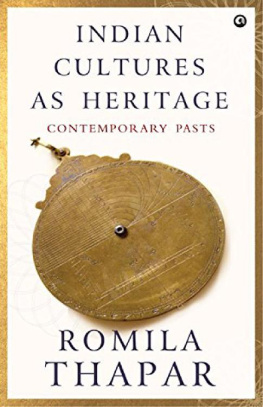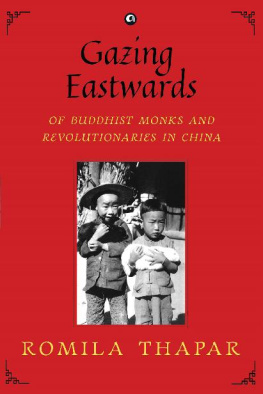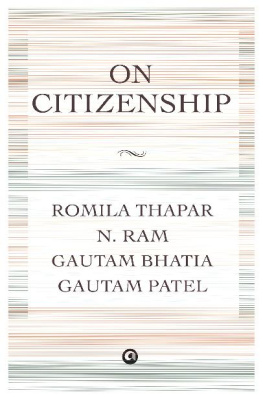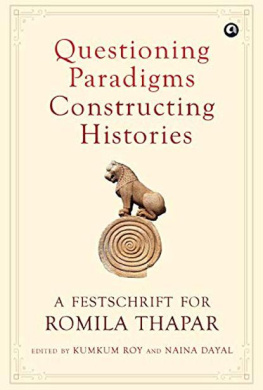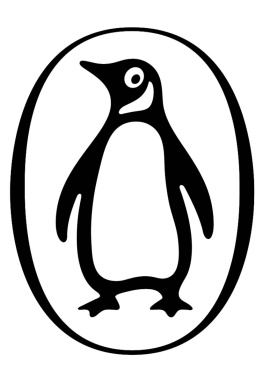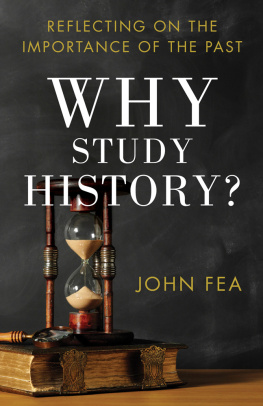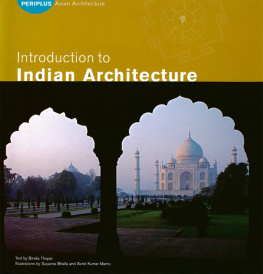ALEPH BOOK COMPANY
An independent publishing firm
promoted by Rupa Publications India
This book is for the youngest ones I knowHamir, Safik, Amrit and Sujanin the hope that when on becoming adults they read it, it may help them to decide on what is worth protecting in their heritage.
First published in India in 2014 by
Aleph Book Company
7/16 Ansari Road, Daryaganj
New Delhi 110 002
Copyright Romila Thapar 2014
All rights reserved.
This is a work of fiction. Names, characters, places and incidents are either the product of the authors imagination or are used fictitiously and any resemblance to any actual persons, living or dead, events or locales is entirely coincidental.
No part of this publication may be reproduced, transmitted, or stored in a retrieval system, in any form or by any means, without permission in writing from Aleph Book Company.
eISBN: 978-93-83064-50-2
This book is sold subject to the condition that it shall not, by way of trade or otherwise, be lent, resold, hired out, or otherwise circulated without the publishers prior consent in any form of binding or cover other than that in which it is published.
This book is for the youngest ones I knowHamir, Safik, Amrit and Sujanin the hope that when on becoming adults they read it, it may help them to decide on what is worth protecting in their heritage.
CONTENTS
A NOTE ON TERMS USED IN THIS TEXT
Hindus
The word Hindu as the name of a religion does not occur in Indian sources until quite late in about the fourteenth century AD. The term dharma was used in an ethical sense and not as the name of a religion. The edicts of the Mauryan Emperor Ashoka (third century BC) refer to various religious sects and mention the two broad groups as bamanashramanambrahmanas and shramanas (from Buddhist and Jaina monks). This form is also given by the Greek Megasthenes who writes about Mauryan India, and refers to those associated with religion as consisting of two groups, the Brachmanes and the Sarmanes. The mention of these continues into later times as for example in the grammar of Patanjali who mentions the two and their opposition to each other. Al-Biruni writing in the eleventh century refers again to the brahmans and the shamaniyyas. Possibly by now the latter category may have included a variety of other heterodox sects. The two were not rigid religious identities but covered a range of sects in varying degrees of agreement and disagreement.
What is of interest in the history of the term Hindu, is that its origin lies in its being a geographical name. It goes back to references to Sindhu, the Indo-Aryan/Vedic Sanskrit name for the Indus river. When the Indus region and the north-western borderlands became part of the Achaemenid Empire of Iran in the mid-first millennium BC, this area was referred to in Achaemenid inscriptions as Gandara and Hin[d] ush, the Indo-Aryan s changing to h in Old Persian. The Indo-Greeks referred to the river as Indos. Subsequent to this the Arabs referred to this area and that beyond the Indus, as al-Hind, and the people came to be called Hindu.
The geographical identity of the term Hindu remained current until about the fourteenth century when gradually the name came to be applied to all those who lived in al-Hind but were not Muslims. The entire range of non-Muslims came to be termed Hindus. The distinction between brahmanas and shramanas begins to fade.
The colonial view of religion in India differentiated between Islam which they were familiar with from the Crusades and as the religion of west Asia, and the Hindus that were more diverse and less familiar. So the sects of the Hindus were brought under a single umbrella and this was labeled Hinduism.
Some scholars of the history of Hinduism would trace it back to the Indus Civilization but little is known for sure about this. Suggestions have been made some of which link it to the later religion and some do not. Once the pictograms are deciphered then there might be more knowledge about the religion of this civilization and whether it forms a prior history of the later religion.
The known history of the Hindu religion begins with Vedic Brahmanism from the late second millennium BC and winds its way through a variety of sects, belief systems and ritual practices to the present. It is therefore not possible to date it precisely. Jainism, Buddhism, Christianity and Islam, were all founded at a particular point in time, by a historical person. This makes them different from Hinduism.
Vedic Age
Historians regard the Vedic age as the age when the Vedas were composed and recorded. The generally accepted time bracket ranges from about 1500 BC to 600 BC. The Rigveda was composed in the period from 1500 to 1000 BC and was compiled and edited thereafter. The other three Vedasthe Sama, Yajur and Atharvadate to the period after 1000 BC. This was also the period when technical works on grammar, etymology and phonetics were composed.
Indus Civilization
Cultures of the Indus plain and the north-western borderlands of the sub-continent, that evolved from agro-pastoralism and agrarian settlements gave rise to city cultures such as those of Harappa and Mohenjo-daro, in both these areas in the early third millennium BC. The early stages are traced to sites in Baluchistan such as Pirak and Mehrgarh and to Kot Diji and Mundigak in the borderlands. There is in this area an archaeological record of a gradual evolution towards urbanism. Attempts have been made to suggest that there was an earlier evolution of cities in the Cholistan area of southern Punjab in Pakistan, on the now extinct Hakra river which some have identified with the extinct Sarasvati. Hence the occasional use of the label Indus-Sarasvati Civilization. However the evidence for this suggested earlier beginning is not generally accepted. The Hakra disappeared in the early second millennium BC and the identity of the Sarasvati with the present-day Ghaggar is uncertain. There is also the problem that the Haraxvati in the Helmand area of Seistan in Afghanistan, neighbouring Baluchistan and northeastern Iran, could as well have been the river referred to in the early Rigveda. Given the interchange of the s sound with the h sound, the Old Iranian Haraxvati would have been rendered as Sarasvati in Indo-Aryan.
Harappa Culture
Archaeological cultures are sometimes named after the first site discovered of a particular culture. In the case of the city-based Indus Civilization, excavations at Harappa were among the earliest. Therefore the cities are sometimes referred to as those of the Harappa Culture.
Vedic People
This label is sometimes used when referring to the people who are thought to have created the culture encapsulated in the Vedic texts or Vedic Corpus. It is not the most precise term as the span of the Corpus covers a millennium. With the discovery of various archaeological cultures in northern India during the period from 1500-500 BC, the mapping of the different cultures is becoming a little clearer. This discourages the use of a blanket term that does not differentiate between the cultures.
Ancient Aryans
The term Aryan is often used casually to mean many things. Initially it referred to people who spoke and used a particular language, namely, Indo-Aryan. By extension it sometimes included those who observed a recognizable cultural pattern in their social relationsthe caste system, and who in their belief systems were generally in agreement with views propounded in the Vedic Corpus. Aryan is not a race. However the application of the label underwent changes in the course of history and came to refer to various other categories and groups.


